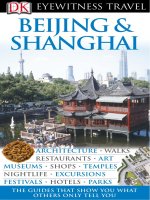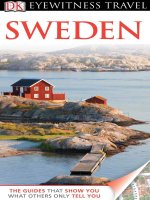stockholm (eyewitness travel guides)
Bạn đang xem bản rút gọn của tài liệu. Xem và tải ngay bản đầy đủ của tài liệu tại đây (25.16 MB, 234 trang )
THE GUIDES THAT SHOW YOU WHAT
OTHERS ONLY TELL YOU
EYEWITNESS TRAVEL
STOCKHOLM
ART & DESIGN
•
CAFÉS
RESTAURANTS
•
NATURE
NIGHTLIFE
•
SHOPPING
ISLANDS
•
ROYAL PALACES
HOTELS
•
MUSEUMS
•
MAPS
EYEWITNESS TRAVEL
STOCKH OLMEYEWITNESS TRAVEL
STOCKHOLM
MAIN CONTRIBUTOR
:
KAJ SANDELL
Dawn at Skeppsbron, on the eastern side of Gamla Stan
The information in this
Dorling Kindersley Travel Guide is checked regularly.
Every effort has been made to ensure that this book is as up-to-date as
possible at the time of going to press. Some details, however, such as
telephone numbers, opening hours, prices, gallery hanging
arrangements and travel information are liable to change. The
publishers cannot accept responsibility for any consequences arising
from the use of this book, nor for any material on third party websites,
and cannot guarantee that any website address in this book will be
a suitable source of travel information. We value the views and
suggestions of our readers very highly. Please write to: Publisher,
DK Eyewitness Travel Guides, Dorling Kindersley, 80 Strand,
London WC2R 0RL, Great Britain.
Kaknästornet, Stockholm’s tallest
building at 155 m (508 ft)
Produced by Streiffert Förlag AB, Stockholm
CHIEF EDITOR Bo Streiffert
PROJECT EDITOR Guy Engström
EDITORS Monica Nilsson, Guy Engström
DESIGNER Bo Streiffert
PICTURE RESEARCH Guy Engström
Dorling Kindersley Ltd
MANAGING EDITOR Anna Streiffert
ART DIRECTOR Gillian Allan
MAIN CONTRIBUTOR Kaj Sandell
CONTRIBUTORS
Lisa Carlsson, Jan & Christine Samuelson
Christina Sollenberg Britton, Stockholm Information Service
MAPS Stig Söderlind
PHOTOGRAPHERS Jeppe Wikström, Erik Svensson
ILLUSTRATIONS
Urban Frank, assisted by Jan Rojmar
Reproduced by PDC Tangen, Norway
Printed and bound by South China Printing Co. Ltd.,
First American Edition, 2000
10 11 12 13 10 9 8 7 6 5 4 3 2 1
Published in the United States by DK Publishing,
375 Hudson Street, New York, New York 10014
Reprinted with revisions 2001, 2004, 2007, 2010
Copyright 2000, 2010 © Dorling Kindersley Ltd, London
ALL RIGHTS RESERVED. WITHOUT LIMITING THE RIGHTS UNDER COPYRIGHT
RESERVED ABOVE, NO PART OF THIS PUBLICATION MAY BE REPRODUCED, STORED IN
A RETRIEVAL SYSTEM, OR TRANSMITTED IN ANY FORM OR BY ANY MEANS,
(ELECTRONIC, MECHANICAL, PHOTOCOPYING, RECORDING OR OTHERWISE),
WITHOUT THE PRIOR WRITTEN PERMISSION OF THE COPYRIGHT OWNER
AND THE ABOVE PUBLISHER OF THE BOOK.
Published in Great Britain by Dorling Kindersley Limited.
A CATALOGING IN PUBLICATION RECORD IS AVAILABLE
FROM THE LIBRARY OF CONGRESS.
ISBN 1542-1554
ISBN 978-0-75666-051-2
FLOORS ARE REFERRED TO THROUGHOUT IN ACCORDANCE WITH EUROPEAN USAGE; IE
THE “FIRST FLOOR” IS THE FLOOR ABOVE GROUND LEVEL.
INTRODUCING
STOCKHOLM
PUTTING STOCKHOLM
ON THE MAP
10
THE HISTORY OF
STOCKHOLM 14
STOCKHOLM THROUGH
THE YEAR 26
STOCKHOLM AT A
GLANCE 30
Wooden sculpture on the
17th–century warship Vasa
CONTENTS
STOCKHOLM
AREA BY AREA
GAMLA STAN 44
CITY 60
BLASIEHOLMEN &
SKEPPSHOLMEN 74
DJURGARDEN 84
MALMARNA &
FURTHER AFIELD
100
EXCURSIONS FROM
STOCKHOLM 140
Late winter walk along the shores of Kungsholmen
SURVIVAL
GUIDE
PRACTICAL
INFORMATION 190
GETTING TO
STOCKHOLM 198
GETTING AROUND
STOCKHOLM 200
STOCKHOLM STREET
FINDER 206
GENERAL INDEX 219
ACKNOWLEDGEMENTS
229
The renovated Royal chapel at the
Royal Palace
TRAVELLERS’
NEEDS
WHERE TO STAY 154
RESTAURANTS,
CAFES AND PUBS
160
ENTERTAINMENT IN
STOCKHOLM 174
OUTDOOR ACTIVITIES
180
SHOPPING IN
STOCKHOLM 182
The Royal Palace
in Gamla Stan
A packet of traditional round
Swedish crispbread
PHRASE BOOK
231
STOCKHOLM
PUBLIC TRANSPORT
MAP
Inside Back Cover
STOCKHOLM
FOUR GREAT DAYS IN STOCKHOLM 89
PUTTING STOCKHOLM ON THE MAP 1013
THE HISTORY OF STOCKHOLM 1425
STOCKHOLM THROUGH THE YEAR 2629
STOCKHOLM AT A GLANCE 3041
INTRODUCING STOCKHOLM8
MUSEUMS MEANDER
• A sunken ship and Swedish
history on Djurgården
• Lunch near
Kungsträdgården park
• Skeppsholmen – “museum
island”
TWO ADULTS
allow at least 800 kr
Morning
Start the day on the island
of Djurgården at the
Vasa-
museet
(see pp92–4). The
impressive 17th-century war-
ship Vasa is worth at least 90
minutes, and try not to miss
the informative video. Next
door, the
Nordiska Museet
(see pp90–91) gives a
glimpse into Swedish life
over the centuries. Allow
two hours. Leaving the
island over
Djurgårdsbron
(see p88), turn left and a 15-
minute waterside walk down
S
trandvägen brings you to
Kungsträdgården
(see p64).
Around this park are plenty
of places for a lunch break.
Afternoon
Refreshed, head for Skepps-
holmen, passing the stately
Grand Hotel
(see p79) and
the
Nationalmuseum
(see
pp82–3). Once there, you can
choose between the
Moderna
Museet
(see pp80–81) and
the
Arkitekturmuseet
(see
p78). Finish with a late “fika”
(coffee break) in the museum
café, or try the restaurant
with its view over the water.
PALACES AND
WATERWAYS
• Kungliga Slottet (the
Royal Palace)
• The city from the water
• Drottningholm Palace
TWO ADULTS
allow at least 380 kr
Morning
Start the day with a touch of
royalty at
Kungliga Slottet
(see pp50–53), the Royal
Palace, in Gamla Stan. Choose
any combination of tours –
the Royal Apartments, the
Tre Kronor Museet or Gustav
III’s Museum of Antiquities –
which will take up most
of the morning. Then, just
before noon, step outside for
the Changing of the Guard,
complete with full horse
parade over Norrmalm
Bridge. Afterwards, take a
gentle walk through the
cobblestone streets of Gamla
Stan to
Stortorget
(see p54)
for lunch at any one of the
cafés lining the square. The
charming Chokladkoppen is
an excellent choice, popular
with tourists and locals alike.
During the winter holidays,
one of the oldest
Julmarknad (Christmas
Markets) is held here.
I
n Stockholm you are never far
from water. Between them, the
city’s 14 islands offer a beguiling
mix of culture and nature – there is
something for everyone here. As
well as being beautiful seen from
the water, this city is also a
pleasure to explore on foot,
p
articularly around Gamla
Stan’s medieval lanes and
alleys and the leafy island of
Djurgårgen. To help you to make
the most of your visit, here are
ideas for four themed days
out. All the sights are
accessible using public
transport. Prices include
travel, food and admission
charges. Family prices are for
two adults and two children.
FOUR GREAT DAYS IN STOCKHOLM
Drottningholm Palace by boat
Looking over the Nordiska Museet towards the city centre
Hercules outside
Drottningholm
FOUR GREAT DAYS IN STOCKHOLM 9
Afternoon
After lunch it is onto the water.
A one-hour canal cruise to
Drottningholm Palace
(see
pp146–9), the residence of
the Swedish royal family, also
provides a waterfront tour
of the city on the way to the
palace just outside of town.
Be sure to visit the Chinese
Pavilion and the beautiful
summer gardens in the
palace grounds. “Under the
Bridges of Stockholm” is
another popular canal tour,
which takes two hours and
passes all of the city’s major
landmarks.
Coffee and cakes
are available on board.
For both tours, it is worth
booking in advance during
peak times (see pp204–5).
located her
e, with Folkunga-
gatan itself leading towards
Medborgarplatsen
(see p131).
Traditional Swedish lunch
can be had at an outdoor
restaurant on the square.
Afternoon
From Medborgarplatsen
it is not far to
Katarina
Kyrka
(see p128) and the
characteristic 18th-century
cottages of old Södermalm.
For a more contemporary
view of Söder, the stretch
of Götgatan between
Medborgarplatsen and
Slussen has an eclectic mix
of shops, many selling
Swedish design. The area
east of here is
Mosebacke
(see p128). Here you will
find the
Södra Teatern
(see
p176) and a public terrace,
offering amazing views of
the city. A more glamorous
viewing point is the cocktail
bar right at the top of
Katarinahissen
lift (see
p127), accessible from
Slussen
(see p126).
island of Djurgården. Here
you can visit period houses
preserved and transported
from all over Sweden, watch
traditional glass blowing,
and walk through a typical
Swedish town, complete with
market and post office. After
such a busy morning, take
a well-deserved break in
one of the many cafés in
the grounds of the park.
Afternoon
On to
Gröna Lund
(see p95),
an amusement park where
you can ride one of the
roller coasters, float through
the
Tunnel of Love or relax
on the Ferris wheel. Alter-
natively, enter the world of
celebrated children’s author
Astrid Lingren at
Junibacken
(see p88) to explore her
well-loved collection of
books; little ones can play in
Pippi
Longstocking’s house,
the Villa Villekulla. It also
has one of Sweden’s leading
children’s theatres.
A WALK FROM NATURE
TO CULTURE
• The mountain park of Vita
Bergen
• Shopping and eating in
trendy SoFo
• Old Södermalm and the
Katarinahissen lift
TWO ADULTS
allow at least 300 kr
Morning
Begin on the island of Söder-
malm at
Vita Bergen
(see
p130), a beautiful mountain
park. Here you will find
allotment-gardens, worker’s
houses from the early 18th
century and the monumental
Sofia Kyrka
(see p130). Then
head down-hill and into
trendy “SoFo” (the area south
of Folkungagatan). A variety
of boutiques and cafés are
The busy Stortorget square in the
heart of Gamla Stan
Children having fun at Skansen,
on the island of Djurgården
People enjoying picnics at Nytorget in “rustic chic” SoFo
A FULL FAMILY DAY
• A trip to the Skansen zoo
and open-air park
• Amusements at Gröna Lund
• The world of Pippi
Longstocking and a theatre
visit at Junibacken
FAMILY OF 4
allow at least 900 kr
Morning
Start the day at the world’s
oldest open-air museum and
zoo of Scandinavian wildlife,
Skansen
(see pp96–7), on the
Putting Stockholm on the Map
Sweden is Europe’s fourth largest country, covering 486,661
sq km (187,900 sq miles). Its southern-most point is on the
same latitude as Edinburgh; its northern extremity is 280 km
(174 miles) north of the Arctic Circle. Sweden borders Norway
in the west and Finland in the east. Since 2000 it has been
connected to Denmark in the south via a bridge over the
Öresund strait. The capital, Stockholm, is in the south-east. It
has around one million inhabitants. The city is built on islands
which separate the Baltic Sea from Lake Mälaren (see pp40–1).
INTRODUCING STOCKHOLM10
04-0
4USÚNTUBE
'SFESJLTUBE
4BOEFGKPSE
4,"(&33",
)JSUTIBMT
'SFEFSJLTIBWO
(PUIFOCVSH
7ÊOFSO
&
&&
&
&
450$,)0
/ZOÊTIBNO
,BQFMMTLÊS
&
&
&
37%$%.
./27!9
&
$% !2+
$01&/)"(&/
)FMTJOHÚS
&
&
&
&&
#"-5*$
0/,!.$
4XJOPVKTDJF
&
&
(EBOTL
(EZOJB
(SJTTMFIBNO
(6-'0'
&
&
&
7ÊUUFSO
&
&
&
&
&
&
(SFOÌ
7BSCFSH
)FMTJOHCPSH
-BSWJL
,BSMTLSPOB
&
&
&
&
7JTCZ
0TLBSTIBNO
½MBOE
(PUMBOE
4JNSJTIBNO
3ÚOOF
#PSOIPMN
(FETFS
&
.BMNÚ
:TUBE
5SFMMFCPSH
3PTUPDL
1VUUHBSEFO
'%2-!.9
4BTTOJU[
3ÚECZ
&
&
&
5SBWFNàOEF
,JFM
)BNCVSH
&
&
.EWCASTLE
+RISTIAN
SAND
KEY
Airport
Ferry port
Motorway
Major road
Railway
National border
View of Stockholm from Mosebacke, painted in 1787 by Elias Martin
0 kilometres 100
0 miles 50
PUTTING STOCKHOLM OM THE MAP 11
.BSJFIBNO
¯MBOE
4&"
3TOCKHOLM
)#%,!.$
"5-"/5*$0$&"/
/PSUI
4FB
./27!9
37%$%.
&).,!.$
'2%!4
"2)4!).
)2%,!.$
'%2-!.9
0/,!.$
"%,!253
2533)!
5+2!).%
&2!.#%
)4!,9
2/-!.)!
$%.
-!2+
%34/.)!
,!46)!
,)4(5!.)!
2533)!
,58%-"/52'
.%4(%2
,!.$3
"%,')5-
37)4:%2,!.$
!5342)!
#:%#(
2%05",)#
3,/6!+)!
(5.'!29
-/,$/6!
3%2")!
3,/6%.)!
#2/!4)!
"(
.
&
"
&).,!.$
&
&
&
&
,!46)!
,)4(5!.)!
2533)!
3*("
"
"
"
&
&
&
,BMJOJOHSBE
"
.
.
"
"
"
&DLFSÚ
#05)/*"
%34/.)!
5" *//
)&-4*/,*
5VSLV¯CP
&
3T0ETERSBURG
6QQTBMB
7ÊTUFSÌT
&TLJMTUVOB
.BSJFGSFE
/ZLÚQJOH
7BYIPMN
4JHUVOB
/ZOÊTIBNO
/PSSUÊMKF
5SPTB
&OLÚQJOH
4USÊOHOÊT
!RLANDA
.ÊMBSFO
#"-5*$4&"
&
&
&
&
&
Aerial view of central Stockholm
GREATER STOCKHOLM AND SURROUNDINGS
NORTHERN EUROPE
Stockholm and surroundings
Stockholm has excellent road, railway
and ferry links to many interesting sights
in the surrounding area (see pp140–51).
0 kilometres
0 miles
50
30
34/#+(/,-
.-"3&/
$ROTTNING
HOLM
4ÚEFSUÊMKF
7ÊTUFSIBOJOHF
)BOEFO
5VNCB
"IRKA
-ARIEFRED
3TENINGE
4JHUVOB
&OLÚQJOH
4USÊOHOÊT
'ÊSJOHTÚ
"EFMTÚ
#KÚSLÚ
&LFSÚ
-PWÚO
7" &/
56/"
4*(56/"
611-"/%4#30
611-"/%4
74#:
+3' "
40 &/
56/"
5#:
%"/%&
3:%
-*%*/(½
&,&3½
)6%%*/(&
4"-&.
#05,:3,"
/:/4)"./
4½%&35-+&
6114"-"
)¯#0
&/,½1*/(
453/(/4
(/&45"
!RLANDA
&
&
&&
&
&
&
.VOTÚ
Stockholm and Surroundings
Stockholm’s first buildings were erected on a small
island in the narrow Strömmen channel between the
Baltic and Lake Mälaren. When the town started to
expand, buildings sprang up on the “Malms”, the
areas on either side of Strömmen. Today Stockholm
stretches over 14 islands, with high-rise suburbs
sprawling almost all the way out to the royal country
palaces. The network of underground and suburban
trains, buses and ferry services offers easy transport
to sights beyond the city centre (see pp140–51).
INTRODUCING STOCKHOLM12
40-/"
46/%#:#&3(
"ROMMA
#"-5*$4&"
3ANDHAMN
6AXHOLM
4BMUTKÚCBEFO
4UBWTOÊT
#MJEÚ
7ÊEEÚ
3ÌENBOTÚ
:YMBO
.ÚKB
*OHBSÚ
3VONBSÚ
/ÊNOEÚ
7ÊSNEÚ
0SOÚ
(ÌMÚ
/-KVTUFSÚ
4-KVTUFSÚ
#PHFTVOET
MBOEFU
/0335-+&
½45&3¯,&3
7"9)0
/"$,"
73.%½
5:3&4½
)"/*/(&
&
PUTTING STOCKHOLM ON THE MAP 13
STOCKHOLM
0 kilometres
0 miles
5
5
0 kilometres
0 miles
10
10
KEY
Greater Stockholm
Motorway
Major road
Minor road
Airport
Railway
Railway station
Ferry
INTRODUCING STOCKHOLM 15
L
egends and theories about Stockholm’s origins have been many
and varied, and sometimes even contradictory. But they
have a common factor – control over the waterways. The
generally accepted founder of Stockholm is the 13th-century regent
Birger Jarl who, according to the medieval Erik’s Chronicle, wanted
to build a fortress to protect Lake Mälaren from marauding pirates.
A thousand years ago the
waters around the island
now known as Gamla Stan
were busy with warships,
trading vessels and pirate
ships using the narrow
channel between the Baltic
and Lake Mälaren. In those
days boat was the quickest
and safest method of travel.
In
the first literary mention
of what was to become Stockholm,
the Icelandic poet and saga writer
Snorre Sturlasson (1178–1241) des-
cribed a barrier of piles across a
w
aterway which he named Stock-
sundet, the present Norrström. The
island formed by this piling became
known as Stockholm. Excavations in
the late 1970s revealed the remains
of a large number of piles in the water
dating from the 11th century. Snorre
also mentioned a 12th- century castle
tower which would have predated
Birger Jarl’s fortress, the predecessor
of the present Royal Palace.
D
ocuments show that Stockholm
was already a city in 1252, four years
after Birger Jarl became regent. Many
towns in Sweden started to expand
in the early 13th century. Stockholm
was a late starter but soon caught up.
A document from 1289 describes
Stockholm as the biggest
place in the kingdom. But
it was not the capital city,
because the king was
always on the move.
Birger Jarl’s son, King
Magnus Ladulås, did not
regard Stockholm as his
capital either. For a long
time the city’s importance
lay in its role as a trading
centre. It became an important port
for
the German-dominated Hanseatic
League, which controlled Swedish
overseas trade from the 13th century
until the late 17th century.
T
he frontiers of the Nordic coun-
tries remained undefined for some
time, but with a background of sim-
ilar languages and cultures, Sweden,
Norway and Denmark signed the
Kalmar Union in 1397. Finland at that
time was still part of Sweden. The era
of union became one of conflict and
violence. At the battle of Brunkeberg
in Stockholm in 1471 the Danish
king tried to take control of Sweden,
but was defeated by the regent Sten
Sture. A new Danish campaign in
1520 culminated in the notorious
Stockholm Bloodbath at Stortorget
(see p54), when more than 80
Swedish noblemen were executed.
1000
1100
1200
1300
1400
TIMELINE
Painting in Storkyrkan (Stockholm’s cathedral) depicting a remarkable light phenomenon seen in 1535
THE HISTORY OF STOCKHOLM
Stockholm’s oldest
preserved city seal (1296)
c.1250
Birger Jarl
founds Stockholm
1280
Ordi-
nances of
Alsnö give
nobility free-
dom from
taxation
Birger Jarl,
Stockholm’s
founder
1008
Olof Skötkonung
converts to Christianity
and is baptized in
Västergötland
1275
Magnus Ladulås chosen
as Sweden’s king at Mora
1471
Sten Sture the Elder
defeats the Danish King
Kristian at Brunkeberg
1350
Code of
Magnus Eriksson re-
places provincial laws
1349–50
Plague
ravages Sweden
1364
Albrecht of Mecklenburg
chosen as Sweden’s King
1397
Kalmar Union links
the Nordic countries
1520
Swedish
noblemen
executed in
Stockholm
Bloodbath
1101
Three Kings’
Meeting fixes
Scandinavian frontiers
800–975
Vikings
settle and trade at
Birka (see p144)
1500
INTRODUCING STOCKHOLM16
TIMELINE
1525
1550
1575
1600
THE VASA ERA
One of those who managed to avoid
execution in the Stockholm Bloodbath
was the young nobleman Gustav
Eriksson. At the end of 1520 Gustav
organized an army to oust the Danish
King Kristian from Sweden. Gustav
was successful and on 6 June 1523 –
later to become Sweden’s National
Day – he was named king
with the title Gustav Vasa.
When
Gustav Vasa took the
throne he discovered a nation
in financial crisis. He called on
Parliament to pass a contro-
versial law transferring the
property of the Church to the
State, which then became the
country’s most important
source of economic power.
Another important result of
this policy was the gradual
separation from Catholicism
and
the adoption of the Luth-
eran State Church.
During his reign Gustav Vasa
implemented tough economic policies
in order to concentrate central power
in Stockholm. This effective dictator-
ship also resulted in the Swedish
Parliament’s decision in 1544 to make
the monarchy hereditary.
D
escendants of Gustav Vasa oversaw
the rise of Sweden into one of Europe’s
great powers. During the reign of
Gustav’s son Erik XIV, there were wars
against Denmark, Lübeck and Poland.
His brothers dethroned him and he died
in prison, probably of a pea soup poi-
soned by his brother Johan III.
During the reign of Karl IX, the
third son, Sweden waged war
against Denmark and Russia.
GUSTAV II ADOLF
AND KRISTINA
When the next king, Gustav II
Adolf, came to power in 1611,
Sweden was involved in wars
against Russia, Poland and
Denmark. Under his rule
Sweden steadily increased its
influence over the Baltic
region. Stockholm started to
develop into the country’s
political and administrative
c
entre. In 1630 Gustav II Adolf, to-
gether with his influential chancellor
Axel Oxenstierna, decided to inter-
vene in the Thirty Years War on the
1561
Eric XIV
is crowned king and his
brothers’ powers curbed
1569
Johan III
crowned in Stockholm
1568
Erik XIV imprisoned by
his brothers at Gripsholms Slott
1544
Heredi-
tary monarchy
established for
Gustav Vasa’s
male descen-
dants
1560
Gustav
Vasa dies
1523
Gustav Vasa
chosen as king in
Strängnäs and
marches into
Stockholm
The newly chosen king, Gustav Vasa, making his ceremonial entry into Stockholm, Midsummer Day 1523
1542
Nils Dacke
and supporters
stage a
peasant revolt in
Småland
1527
Reformation,
Parliament
confiscates Church
property
1570
Nordic Seven
Years War ends
1587
Johan III’s son
Sigismund chosen
king of Poland
1611
Gustav II
Adolf
comes to
power
1612
Axel
Oxenstierna
named State
Chancellor
Portrait of
Erik XIV (1561)
1577
Erik XIV dies,
probably poisoned
Vasa dynasty’s
coat of arms
THE HISTORY OF STOCKHOLM 17
1625
1650
1675
1700
side of the Protestants, using religious
motives as a pretext. Sweden had
some notable military successes dur-
ing the war, but paid a heavy price for
winning the bloody battle at Lützen in
1632 as the king was killed in action.
Gustav
II Adolf’s only child, Kristina,
came to the throne at the age of six.
During her reign (1633–54), life at the
court was influenced by the world of
science and philosophy. Kristina
corresponded with leading academics
and invited the French philosopher
René Descartes, who died in 1650 only
a few months after arriving in
Stockholm. The Tre Kronor castle
became the permanent royal
residence. Kristina’s reluctance to
marry resulted in her cousin, Karl
Gustav, becoming Crown Prince.
Kristina abdicated and left for Rome,
where she converted to Catholicism.
the frozen waters of the Great Belt (see
p19). Karl XI (1660–97) secured the
southern Swedish provinces, and
divided the land more evenly between
the crown, nobility and peasants.
W
hile the body of Karl XI lay in state
at Tre Kronor in 1697 a fire broke out
which destroyed most of the building.
The new monarch was the teenage Karl
XII (1697–1718). He faced awesome
problems when Denmark, Poland and
Russia formed an alliance in 1700 with
the aim of crushing the power of
Sweden. Karl XII set off to battle.
D
enmark and Poland were soon
forced to plead for peace, but Russia
resisted. A bold push towards Moscow
was unsuccessful and the Swedish army
suffered a devastating defeat at Poltava
in 1709. This marked the beginning of
the end for Sweden as a great power.
K
arl XII, the most controversial
Swedish monarch, returned to Sweden
in 1715 after an absence of 15 years.
His plans to regain Sweden’s position
of dominance never came to pass and
he was killed in Norway in 1718.
By
now, Sweden was in crisis. Crop
failures and epidemics had annihilated
one-third of Stockholm’s population
and the state’s finances were drained.
1718
Karl XII dies
Karl XII with the widowed queen on his arm
leaving the burning Tre Kronor fortress
1618
Thirty
Years War
starts in
Germany
1617
Death penalty introduced
for conversion to Catholicism
1632
Gustav II
Adolf killed at
battle of Lützen
1655
Kristina converts to Catholicism
and is ceremonially greeted in Rome
1654
Kristina abdicates and
Karl X Gustav crowned king
1658
Swedish army
crosses the Great
Belt and acquires
new territory under
Peace of Roskilde
1680
Karl XI starts
the era of Carolian
autocracy and
limits powers of
the nobility
1709
Swedish
army defeated by
Peter the Great
at Poltava
1697
Tre Kronor
castle destroyed by
fire; 15-year-old
Karl XII crowned
THE CAROLIAN ERA
Karl X Gustav (1654–60) was the first
of three Karls to reign. At the height of
Sweden’s era as a great power and in
one of the most audacious episodes in
the history of war, he conquered
Denmark by leading his army across
Queen Kristina, fascinated by science and
corresponding with leading scientists
1633
Six-year-old
Kristina becomes
queen; guardians rule
1648
Peace of
Westphalia gives
Sweden new
territories
Gustav II Adolf
INTRODUCING STOCKHOLM18
Sweden’s Era as a Great Power
The Tre Kronor Castle
Built as a defensive tower in the 1180s, the Tre Kronor
castle was the seat of Swedish monarchs from the
1520s and became the administrative centre of the
Swedish Empire. It was named after the three crowns
on the spire which burned down in 1697.
Stockholm in 1640
The city’s transformation from
a small medieval town into a
capital city can be seen in the
network of straight streets,
similar to the present layout.
The columns of troops
ride out over the shifting ice
towards Danish Lolland.
SWEDISH EMPIRE
For more than a century (1611–1721) Sweden was the
dominant power in northern Europe, and the Baltic
was effectively a Swedish inland sea. The country was
at its most powerful after the Peace of Roskilde in
1658, when Sweden acquired seven new provinces
from Denmark and Norway. Outside today’s frontiers
the Swedish Empire covered the whole of Finland,
large parts of the Baltic, and important areas of north-
ern Germany. Over 111 years as a great power Sweden
spent 72 of them at war when many treasures were
brought back to the new palaces. It was also an era of
cultural development and efficient government.
THE THIRTY YEARS WAR
A major European war raged between 1618–48,
largely on German soil. Sweden entered the war in
1631 in an alliance with France. Gustav II Adolf was a
fine military leader and had modernized the Swedish
army which immediately had major successes at the
battles of Breitenfeld (1631) and Lützen (1632), where
the king, however, was killed. Later the Swedes
pressed into south-
ern Germany and
also captured and
plundered Prague
(1648). Some rich
cultural treasures
were brought back
to Sweden from the
war. In 1648 the
Peace of Westphalia
gave Sweden several
important posses-
sions in northern
G
ermany.
The death of Gustav II Adolf at the
Battle of Lützen in 1632
Sweden’s empire after the
Peace of Roskilde, 1658
THE HISTORY OF STOCKHOLM 19
Karl XII’s Last Journey
After being hit by a fatal bullet at Fred-
rikshald in Norway (1718), the king’s
body was taken first to Swedish territory
then on to Uddevalla for embalming.
Painting by Gustav Cederström (1878).
CROSSING THE GREAT BELT
When Denmark declared war on Sweden in
autumn 1657, the Swedish army was in Poland.
Marching west, Karl X Gustav captured the
Danish mainland, but without the navy, he
could not continue to Copenhagen. However,
unusually severe weather froze the sea, making
it possible for the soldiers to cross the ice of
the Great Belt, and the Danes had to surrender.
Karl XII’s Pocket Watch
The warrior king’s watch-
case dates from 1700. It
shows the state coat of
arms, as well as those of
the 49 provinces that
belonged to Sweden at
that time.
Count Carl Gustaf
Wrangel
(see p56).
The Powerful Nobility
The nobility were very
influential in the Empire era
and many successful soldiers
were ennobled. The Banér
family coat of arms from
1651 is adorned by three
helmets and barons’ crowns.
Karl XI’s Triumphs
The roof painting in Karl
XI’s gallery at the Royal
Palace (1693) by the
French artist Jacques
Foucquet shows in
allegoric form the king’s
victories at Halmstad,
Lund and Landskrona.
Bondeska Palatset
One of the leading buildings of
the era (1662–73), this palace
was designed by Tessin the
Elder and Jean de la Vallée for
the State Treasurer Gustav
Bonde (see p58).
King Karl X Gustav
himself leads the Swedish
army of 17,000 men.
INTRODUCING STOCKHOLM20
THE AGE OF LIBERTY AND
THE GUSTAVIAN ERA
A new constitution came into force in
1719 which transferred power from the
monarch to parliament. As a result,
Sweden developed a system of parlia-
mentary democracy similar to that of
Britain in the early 18th century.
The
“Age of Liberty” coincided with
the Enlightenment, with dramatic
advances in culture, science and indus-
try. The botanist Carl von Linné became
one of the most famous Swedes of his
time. Another was the scientist, philoso-
pher and author Emanuel Swedenborg.
The production of textiles expanded in
Stockholm, and Sweden’s first hospital
was constructed on Kungsholmen.
C
hanges in the balance of power
around 1770 gave the new king, Gustav
III, an opportunity to strike in an
attempt to regain his monarchical
powers. On 19 August 1772 Gustav
accompanied the guards’ parade to the
R
oyal Palace where, in front of his life-
guards, he declared his intention to
mount a bloodless coup d’état. The
guards and other military units in Stock-
holm swore allegiance to the king, who
tied a white handkerchief round his arm
as a badge and rode out into the city to
be acclaimed by his people. Absolute
power had been restored.
G
ustav III was influenced by the Age
of Enlightenment and by French cul-
ture, which had a great effect on
Swedish cultural life (see pp22–3). But
over the years opposition grew to the
king’s absolute powers, largely because
of his costly war against Russia. In 1792
he was murdered by a nobleman,
Captain Anckarström, during a masked
ball at the Opera House (see p23).
G
ustav III was succeeded by his son,
Gustav IV Adolf. During his reign
Sweden was dragged into the
Napoleonic wars. After a war against
Russia in 1808–9, Sweden lost its
sovereignty over Finland, which at the
t
ime accounted for one-third of
Swedish territory. The king abdicated
and left Stockholm to flee the country.
TIMELINE
1738
Parliamentary power is
established in the Age of
Liberty as the “Hat” party
wins elections
1786
Swedish
Academy founded
1772
Gustav III
crowned and
mounts coup
d’état giving the
king absolute
power
1780s
Immigrants are given
wide religious freedom
1778
National costume
decreed. Death penalty
removed for some crimes
Gustav III with the white armband he wore when
mounting his coup d’état in 1772
1719
New
constitution
transfers power
from the king
to Parliament
1741
Carl von Linné
appointed professor at
Uppsala
Carl von Linné (1707–78)
1790
Swedish defeat
over Russia at battle
of Svenskund
1792
Gustav III
murdered
1720
1760 1780
1800
1740
1754
Royal family moves
into Royal Palace
Napoleon’s former marshal, Jean-Baptiste Bernadotte,
as King Karl XIV Johan surrounded by his family
THE ERA OF KARL JOHAN AND
BOURGEOIS LIBERALISM
By the early 19th century the absolute
powers of the monarch had been
removed for all time, and the privileges
THE HISTORY OF STOCKHOLM 21
of the aristocracy were undermined
even more in 1809 with a new consti-
tution that divided power between the
king, the government and parliament.
W
ith a new class structure and the
effect of the French Revolution, a new
middle class emerged which also
wanted to be more influential. One of
the
best-known newspapers founded
around this time was the liberal
mouthpiece, Aftonbladet.
Difficulties in finding a suitable new
monarch led eventually to the choice
of one of Napoleon’s marshals, Jean-
Baptiste Bernadotte, who took on the
more authentic Swedish name of Karl
Johan. Founder of the pre-
sent royal dynasty, Karl XIV
Johan continued to speak
French and never fully
learned the Swedish lan-
guage. His French wife,
Queen Desideria, found
Stockholm
a cultural back-
water compared with Paris.
In 1813 a Swedish army
with Karl Johan at its head
became involved in a cam-
paign against Napoleon.
The Battle of Leipzig ended
in defeat for France, but
more significantly Denmark had to
hand over Norway to Sweden. The
Norwegians were reluctant to
unite with Sweden, but a
union between the two coun-
tries was agreed which lasted
from 1814 to 1905. A long era
of peace began and with it
came a dramatic increase in
the country’s population,
which grew by 1 million to
3.5 million by 1850. Many
Swedes were driven into
poverty because there was
not enough work to go round.
Mass emigration followed. From the
1850s to the 1930s about 1.5 million
people left Sweden. Most of the
emigrants travelled to North America
in search of a better life.
1809
Sweden loses Finland and
Gustav IV Adolf abdicates
1869
Emigration to North America
increases due to crop failures
1818
Karl XIV Johan is crowned
King of Sweden and Norway
1859
Sweden’s first
railway opens
1842
Primary schools established
by decree in every parish
1908
Royal
Dramatic
Theatre
opens
1810
Parliament chooses
Jean-Baptiste Bernadotte as
Crown Prince
1814
Sweden gains
Norway in peace treaty
with Denmark
1879
August Strindberg’s
novel The Red Room is
published
1850
Sweden has 3.5
million population, 93,000
living in Stockholm
Stockholm’s Eldkvarn mill,
destroyed by fire in 1878
August Strindberg
Newspaper readers outside the Aftonbladet office in 1841
1876
L M Ericsson
starts manufacture
of telephones
1905
Parliament dissolves
union with Norway
1820 1840 1860
1880 1900
FOLK MOVEMENTS AND
INDUSTRIALIZATION
As Sweden was transformed from an
agricultural society into an industria-
lized country the problems posed by
the population surplus were gradually
tackled. Its industrial revolution started
around 1850, gathering momentum in
the late 19th century, and the textile,
timber and iron industries provided the
main sources of employ-
ment. In 1806 the nation’s
f
irst steam-driven mill,
Eldkvarn, was built on the
site of the present-day City
Hall in Stockholm. It con-
tinued production until
destroyed by fire in 1878.
F
olk movements sprang up
in the 19th century which
still play an important role
in Swedish life. A temper-
ance movement emerged
against a background of
alcohol abuse – in the 1820s
annual consumption of spirits was 46
litres (80 pints) per person.
INTRODUCING STOCKHOLM22
The Era of Gustav III
Gustav III (1771–92) is one of the most colourful figures in
Swedish history. The king’s great interest in art, literature
and the theatre made the late 18th century a golden age
for Swedish culture, and several prestigious academies
were founded at this time. After a bloodless revolution in
1772 Gustav III ruled with absolute power and
initiated a wide-ranging programme of reform. But his
attacks on the privileges of the nobility and his
adventurous and costly foreign policy made him
powerful enemies. In 1792 he was murdered during a
masked ball at Stockholm’s Opera House.
COURT LIFE AT DROTTNINGHOLM
Hilleström’s painting (1779) gives an insight into
court life at Drottningholm, where the king resided
between June and November. In the present-day
Blue Salon, Gustav III and Queen Sofia Magdalena
socialized with their inner circle. Behaviour was
modelled on the French court and etiquette was
even stricter at Drottningholm than at Versailles.
Gustav III’s Coronation, 1772
The coronation of the all-powerful
monarch in Stockholm’s cathedral was a
magnificent ceremony, portrayed here by
C G Pilo (1782). Every detail was
overseen by Gustav himself, who used his
flair for the dramatic in politics as well.
The Battle of Svenskund
Gustav III was not known as a
successful warrior king, but in
1790 he led the Swedish fleet to its
greatest victory ever, when it
defeated Russia in a major mari
-
time battle in the Gulf of Finland.
Life in the Inns
The city abounded
with inns, fr
e-
quently visited
by the 70,000
inhabitants. J T
Sergel’s sketch
shows a convivial
dinner party.
The Swedish Academy
The academy was founded by
Gustav III in 1786 to preserve
the Swedish language. Members
received a token depicting the
king’s head at every meeting.
Gustav III
studies
architectural designs.
A courtier
entertains
by reading aloud.
THE HISTORY OF STOCKHOLM 23
Murder at the Masked Ball
In 1792 Gustav III fell victim to a
conspiracy at the Opera House. He was
surrounded by masked men and shot by
Captain Anckarström on the crowded
stage. He died of his wounds 14 days later.
GUSTAVIAN STYLE
The mid-18th century saw the emergence of Neo-
Classicism, with the focus on antiquities and Greek
ideals. Gustav III embraced this
trend with great enthusiasm and
supported the country’s talented
artists and authors. He established
his own Museum of Antiquities (see
pp52–3) with marble sculptures
which he brought home from Italy.
In handicrafts, the sweeping lines of
Rococo elegance were replaced by
the stricter forms of what has
become known as Gustavian Style.
Rooms at the Royal Palace were
renovated with decoration and
furnishings adapted to suit this style.
Bust of Catherine the Great
of Russia, the king’s cousin
Queen Sofia
Magdalena
does
her needlework.
Swedish Court Costume
In 1778 Gustav III introduced
a costume based on French
lines to restrain fashion
excesses. This is the male
court costume for daily wear.
Gustav III’s Mask and Cocked Hat
Despite his mask, Gustav III was easy to recognize
since he was wearing the badges of two orders of
chivalry. The drama intrigued the whole of Europe
and inspired Verdi’s opera Un Ballo in Maschera.
Flogging of the King’s Murderer
Among the conspirators, only Anckarström
was condemned to death. Before he was
taken to his execution in Södermalm he
was flogged on three successive days on
the square in front of Riddarhuset.
Chair designed in
Gustavian Style









